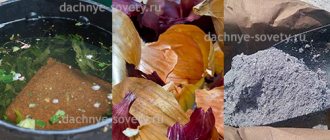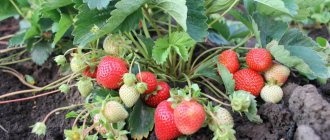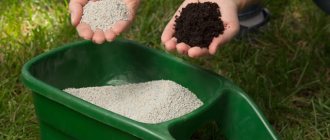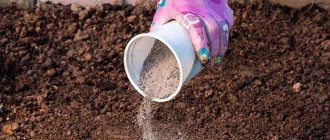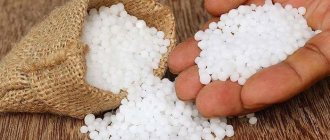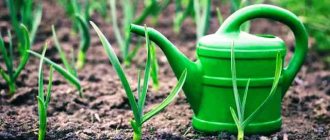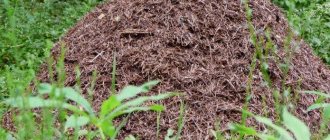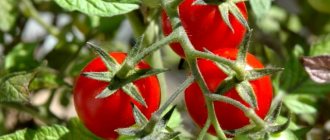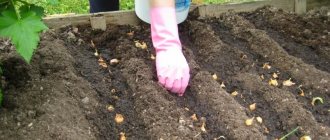In this article we will talk to you about when raspberries need to be fertilized in the spring, as well as how and what kind of fertilizing needs to be applied.
To get a good raspberry harvest, you need to provide the bushes with proper and complete care. It is impossible without proper feeding. Raspberries require special attention in the spring. Now everything is just waking up after a long winter, and therefore fertilizing is more important than ever for plants. It is necessary to do this, otherwise you will not be able to get a good harvest. Let's figure out how and what to feed raspberries in the spring so that they receive adequate nutrition.
How do you know when it’s time to feed raspberries in spring?
Caring for raspberries
As a rule, an experienced gardener can always determine when raspberries need feeding in the spring. So, depending on what specific substances plants lack, they behave differently:
- Nitrogen . When plants do not have enough of this substance, their leaves become pale green and shoot growth slows down.
- Phosphorus . The shoots, despite the fact that they are young, grow thin and weak
- Potassium . The leaves turn brown at the edges
- Iron . The shoots appear yellow leaves with green veins
- Magnesium . The leaves turn yellow from the center to the edges
To get rid of one of the problems, you need to give the plants the right fertilizers. You will notice that the garden bed will bear fruit much better, and the berries will be larger and tastier.
Caring for a remontant variety
It is necessary to properly care for raspberries so that they produce a large harvest.
Remontant varieties of crops usually require the following care:
- In spring, fertilizing with organic matter occurs.
- During the period of flowering, intensive growth and berry setting, minerals are required.
- Three weeks before the cold weather, organic matter is added again.
- Before winter, it is imperative to trim the raspberry bushes and bend them to the ground.
- It is important to dig up the bushes and loosen the soil.
Reference. Mulching the soil for winter is recommended in regions where the air temperature is below -20 degrees in winter. If winters are mild, the plant will tolerate frost well even without mulch.
First feeding of raspberries in early spring: application scheme
Raspberry feeding schedule
The first feeding of raspberries in the spring, as a rule, is combined with loosening the soil. In early spring, it is recommended to use nitrogen fertilizers, in particular urea and ammonium nitrate. It is also advisable to add superphosphate, potassium salt and wood ash.
When feeding, follow a few rules:
- Before adding mineral fertilizers, moisten the soil well. Flush it thoroughly with water. Then the plants will accept feeding very well
- Loosen the soil very carefully, without penetrating deeply. Otherwise, you can disturb the fertile layer and damage the roots, which are now very fragile
- Try not to get the solution on the leaves and stems. Also, be careful not to add too much
- It is recommended to fertilize on cloudy days or in the evening.
When applying inorganic fertilizers, first mulch the soil with organic matter. For example, you can add peat or compost
Fertilizer before planting
It is better to feed raspberries during planting. In this case, the level of soil fertility is not particularly important. Fertilizer will additionally nourish the bushes with vital energy, which may be enough for several years to come. It is imperative to fertilize before planting in the North. This helps young seedlings to take root faster and survive the coming winter well. The following fertilizers are placed in each planting hole:
- humus or compost (10 kg);
- potassium sulfate or sodium humate (50 g);
- wood ash (400 g);
- granulated superphosphate (100 g).
These components must be thoroughly mixed before placing in the hole. The applied fertilizers are sprinkled with a 5-7 cm layer of soil, on which the plant roots are laid.
Raspberries - care in spring after winter: feeding with folk remedies
Raspberries
Often, summer residents use folk remedies. With them, fertilizing raspberries in the spring is much cheaper and turns out to be no less effective. Organic fertilizers are mainly used for these purposes. Let's figure out which ones.
Herbal infusion
This fertilizer is prepared quite simply. Weeds, nettles and comfrey are taken for it. They need to be finely chopped and mixed. The mixture is diluted at the rate of 1 kg per 10 liters of water. At the same time, the concentrate does not need to be used immediately. It must brew for 10 days. After the product has infused, treatment can be carried out. Use 2 liters of solution per bush.
Ash
It is used dry or as a solution. If you take dry ash, then only 100 g per 1 sq.m. is enough. For the solution, 100 g is also taken. This amount is diluted into a bucket of water. Please note that only ash that remains after burning trees and grass can be used for fertilizing. If you have ash from some kind of household waste, then it cannot be used.
Cow dung
This fertilizer is considered one of the most popular. It is not used in finished form, but as a concentrate. It is diluted in a ratio of 1 to 5. The mixture, however, is not used immediately, but is infused for 15-20 days. The container in which the product is stored must be tightly closed. Do not forget that the solution must be stirred regularly. When the concentrate is ready, dilute it with water in a ratio of 1 to 10.
Yeast
For feeding, you can use both dry and live yeast. As for dry ones, for such feeding it is enough to take 10 g of the product and mix it with 5 tbsp. sugar and 10 liters of water. The solution does not need to steep for a long time; it can be left for only two hours. It is also not used in its pure form, but is diluted with water in a ratio of 1 to 5.
If you use live yeast, then you will need 1 kg of product and 1 tbsp. Sahara. You will also need 10 liters of water. At the same time, the solution needs to be infused for 4 hours. After preparation, it is diluted in a ratio of 1 to 20.
Please note that fertilizing must be used immediately, because yeast, when left for too long, begins to ferment.
Bark
Some gardeners use bark for feeding. So, they collect rotten bark from various trees and shrubs, and then break it into small pieces. They scatter all this under the raspberry bushes. When the remaining bark rots, a fertilizer is obtained that gives the raspberries everything they need. You just need to do all this in advance.
Potato peelings
Take dry potato peelings, cut them and pour a liter of boiling water over them. The composition must be infused. For this he needs 3-4 days. After this period is completed, dilute the product in a bucket of water and pour over the raspberries. It is important to understand that you cannot take peelings from diseased potatoes. Otherwise, you can introduce an infection into the raspberries.
Chicken droppings
Its properties are no worse than cow dung. It contains quite a lot of useful substances, or rather, almost everything that raspberries need. The effect of using this product will be noticeable in about a couple of weeks. It is strictly forbidden to use fertilizer undiluted, because then you will destroy the raspberries. So be sure to dilute it before use in a ratio of 1 to 10. Moreover, the solution takes about a day to infuse. 1 liter of solution is diluted into a bucket of water.
Mulch
Some people use mulch for root feeding. This is rotted manure, peat or compost. It has a beneficial effect on plants. First of all, fertilizer gradually nourishes the roots over the course of the season. Moreover, mulch retains moisture near the roots of the bush.
Why does a raspberry need a hot shower?
This procedure is carried out in early spring, while there is still snow, and contributes to the death of a number of parasites, including nematodes. Shower rules:
- They scoop up the garbage between the raspberry bushes, take it outside the boundaries of the site and burn it; parasites and fungal spores often overwinter in it.
- The water is brought to a boil and poured into the watering bowl.
- Treat the semi-shrub with boiling water from a distance of 0.7-1.0 meters.
- Water consumption: 5 liters for 2-4 bushes; if the bushes are voluminous, 10-15 stems, 5 liters per 2 bushes.
This treatment will not harm the dormant buds, and the parasites will definitely be reduced, moreover, by the time the water reaches the stems, its temperature will drop significantly and will be +70 and below.
How to feed remontant raspberries in spring: features
Feeding remontant raspberries
Feeding raspberries in the spring, which are remontant, is carried out with the same means, but their concentration will be much higher. This is due to the fact that it needs to form a double harvest and therefore requires more feeding.
In the spring, as a rule, treatment is carried out using urea or saltpeter, as well as slurry. Urea not only provides nutrition to the soil, but also protects it from various pests. Moreover, treatment can only be carried out after the snow cover has melted.
When the raspberries already begin to bloom and the ovaries appear, fertilizing is carried out using herbal infusions, humus, and always with mixtures of phosphorus and potassium.
Already in the fall, fertilization is carried out using potassium and phosphorus. Each plant requires approximately 40 g of potassium salt, as well as 60 g of superphosphate. The fertilizer is distributed along the furrows and sprinkled with earth, peat and humus.
Ready-made fertilizers for feeding raspberries: list of the best
If you don’t want to bother with preparing fertilizers, then fertilizing raspberries in the spring can be done using ready-made mixtures. For this, complex fertilizers are usually used, which contain everything you need. Please note that they also need to be bred. This is done according to the instructions on the package.
- Gumi-Omi “Berry” . It can be used for a wide variety of shrubs, including raspberries. Its main component is chicken manure. It has a great effect on plants and allows them to grow strong and fruitful.
- Gardeners often purchase specialized fertilizers. The fact is that their effect lasts for a long time, and not for some short time. They are usually available in granule form, which does not require dilution. They can simply be distributed near the bushes and watered. One such product is “Berry Bushes” from Fusco.
Feeding schedule by region
The fertilizer application scheme in different regions is as follows:
| Region | First fertilizing with organic matter | Application of urea | Application of complex fertilizers | Application of phosphorus-potassium fertilizers | Organic feeding |
| Northern regions | April | July | End of July | Mid August | Early October |
| Middle lane | Late March or early April | June | Mid August | Beginning of September | October or November |
| Southern regions | Late February or early March | Mid May or June | June or July (twice) | October | November |
Fertilizing raspberries in spring: mistakes
Mistakes in feeding raspberries
Feeding raspberries in spring requires care. It is important to consider some mistakes that may be made:
- Fertilizer is applied at the wrong time
. A certain time is allocated for each type of fertilizer. Accordingly, if raspberries are fed earlier than expected, they will not be able to properly use all the beneficial substances. - Little or much fertilizer is applied . In this case, you need to observe moderation in everything and follow the instructions. For example, if you add a lot of nitrogen fertilizer, the foliage will grow quickly and there will be a lot of it. But the berries will end up small and tasteless.
- Non-compliance with technology . Apply fertilizer evenly to raspberry bushes. Each of them must receive nutrients.
- Poor quality or unsuitable fertilizers . If your fertilizer is already expired, then don’t even think about using it. In pursuit of savings, you can not only harm the raspberry tree, but even destroy it.
- Use of nitrogenous fertilizers with a high content of chlorine
. Raspberries do not accept chlorine. When its concentration is too high, the plants begin to get sick. In particular, their leaves turn yellow.
Common Mistakes
Even experienced gardeners are not immune to mistakes. Most often they have to deal with problems that arise due to:
- Violations of deadlines for laying fertilizer. If organic matter and mineral fertilizing are not applied at the right time, but earlier or later, then the raspberry simply cannot take full advantage of them, fertilizing does not bring the desired result and the actions have to be repeated several times.
- Incorrect dosage. Excess nutrients cause green mass to grow. At the same time, fewer flowers and ovaries appear on the bush, which negatively affects the harvest. You must follow the instructions printed on the fertilizer package.
- Technology violations. Fertilizers cannot be concentrated in one place; they are distributed evenly over the entire area of the site.
- Expired fertilizer expiration date. If you have an old package of potassium salt lying around in the cellar, the expiration date of which expired several years ago, it is better to throw it away. An expired mixture can cause the death of the bush.
A widespread mistake is also the use of fertilizers that are not suitable for the time or for a particular plant.
Raspberry is a bush plant, in principle, unpretentious and capable of growing on soil of any quality and composition. But if in the spring it is possible to feed the berries correctly, in compliance with the timing and types of fertilizers, then in the summer it will be possible to harvest a harvest 2-3 times higher than usual.
Raspberries - feeding in spring: advice from experienced gardeners
Experienced gardeners know exactly how to fertilize raspberries in the spring. They make several recommendations that are worth paying attention to:
- If you already applied fertilizer when planting a raspberry bush, then you can forget about feeding it for two to three years. If you apply too much fertilizer, the plants will simply die.
- Before adding any nutrients, the bushes need to be watered with clean water. This should be done not before the procedure, but about a couple of hours before. Only then can fertilizer be applied. Otherwise, the roots will get burned.
- If you apply liquid fertilizers, they should not get on the above-ground part of the bush. If liquid gets in, be sure to wash these areas.
- It is recommended to apply fertilizer in the evening or morning, as well as on cloudy days. Do not perform procedures at noon
Root feeding
Applying fertilizer in the spring is very important, as it ensures good growth and fruiting of raspberry bushes. It is better to give preference to root feeding, especially nitrogen and potassium fertilizers.
Before using root feeding, raspberries must be thoroughly weeded and all weeds removed. After this, old shoots should be cut off, since they only take away nutrients and produce little yield. After this, it is necessary to loosen the soil; this should be done shallowly to avoid damage to the root system.
